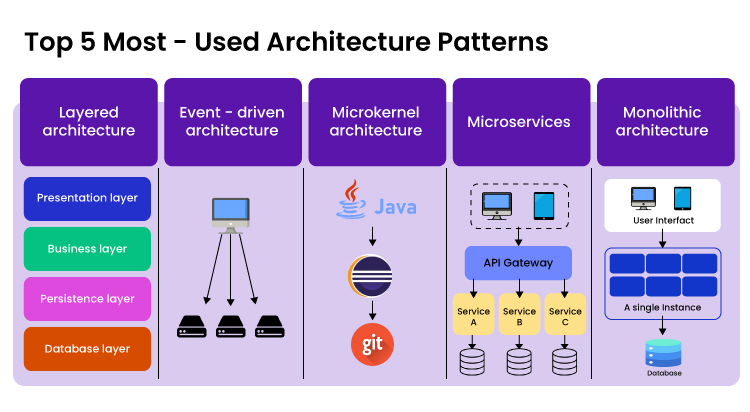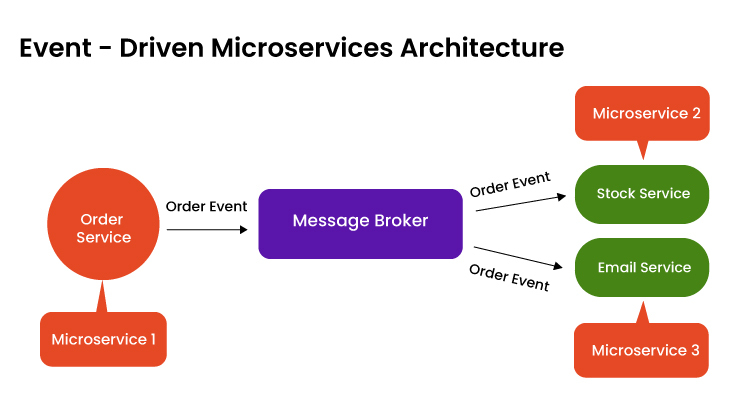软件体系架构方面英文文章翻译——2025年你应该了解的5种以上软件架构模式(用途、优势及更多)
5+ software architecture patterns you should know in 2025 (Usage, Benefits & More)
By Ranju RMay 20, 2024, 3 p.m.

Application development company
Share This Article

Web Application Architecture Ultimate Guide for 2023
This comprehensive eBook provides the ultimate guide to web application architecture in 2023. Read to learn more!
What are software architecture patterns?
Software architecture patterns serve as templates that guide the structuring of software systems, allowing for both efficient and manageable solutions. Each pattern addresses specific system requirements and concerns, which can significantly affect the architecture's performance and sustainability.
Architecture Patterns in Software Development

Understanding and implementing software architecture patterns are crucial for addressing the complex challenges of modern software development. These patterns not only help achieve technical goals but also align with business objectives by supporting the scalability, performance, and security needs of enterprise applications.
Software architecture patterns adapt to changes in technology and business environments, making them indispensable in a developer's arsenal. As technology evolves, these patterns provide the necessary framework to handle new integrations and solutions without overhauling the existing system architecture.
By incorporating these patterns, developers can ensure that their applications are future-proof, able to handle increasing loads, and flexible in integrating with new technologies and systems.
1. Layered Architecture
Layered architecture, also known as n-tier architecture, is a software design approach that organizes applications into discrete layers, each with distinct responsibilities. This setup simplifies the development process and enhances application management and scalability.
Overview of Layered Architecture
The application is divided into at least three primary layers in a typical layered architecture. The presentation layer is responsible for handling all user interfaces and user interactions. It acts as the front end of the application, providing the user interface and gathering user input. Next is the business logic layer, which processes data, applies business rules, and makes decisions.
This layer is the heart of the application's operations, ensuring that business policies and rules are adhered to throughout the application. Finally, the data access layer interacts directly with the database or data storage, retrieving and storing data needed by the application.
This clear delineation of responsibilities helps in maintaining a clean separation of concerns, making the application easier to manage and scale.
Advantages of Layered Architecture
- Simplicity: By separating concerns, the application becomes easier to manage and debug.
- Flexibility: Changes can be made to one layer without affecting others, facilitating updates and maintenance.
- Reusability: Components and services in each layer can be reused in other parts of the application, promoting efficiency.
Implementation Strategy
When implementing a layered architecture, it is crucial to define the responsibilities and operations of each layer clearly:
- Define Layer Responsibilities: Clearly delineate what each layer should do, ensuring that functions do not overlap unnecessarily.
- Use Abstraction: Employ abstract interfaces to manage communications between layers, which helps reduce dependencies and increase the flexibility to change or replace components.
- Business Logic Concentration: Centralize the business rules and decision-making processes within the business logic layer, keeping the presentation layer focused on display and user interaction.
- Efficient Data Handling: Optimize the data access layer to efficiently manage data retrieval and updates, ensuring that it handles all data storage and retrieval without imposing unnecessary loads on the other layers.
Practical Applications
Layered architecture is particularly effective in large, complex applications requiring rigorous maintenance and the ability to scale individual components independently. It is widely favored in enterprise environments where different teams may manage different layers, facilitating better organization and collaboration.
While it offers significant advantages in terms of organization and scalability, the potential for increased complexity and overhead due to multiple layers requires careful management.
2. Client-Server Architecture
Client-server architecture is a foundational concept in software design. In this model, tasks or workloads are divided between service providers (servers) and service requesters (clients). This model is central to various applications, from web browsing to complex enterprise systems.
Overview of Client-Server Architecture
In a client-server architecture, the server performs key functions like data storage, management, and processing requests from clients. The clients, typically user-facing applications, request resources or services from the server, which then responds appropriately. This separation enhances efficiency, manageability, and scalability across networks.
Advantages of Client-Server Architecture
- Centralized Management: The server centralizes control over data and resources, simplifying administrative tasks and system updates.
- Scalability: Servers can be upgraded to handle increased loads, or additional servers can be integrated without major changes to the architecture.
- Enhanced Security: Centralized control allows for better implementation of security measures, such as firewalls and intrusion detection systems.
- Improved Performance: Offloading heavy processing to the server can lead to better overall system performance and quicker client response times.
Implementation Strategy
Implementing a client-server architecture involves several steps:
- Define the Server's Role: Determine what services the server will provide, considering factors like data management, process handling, and security measures.
- Client Design: Develop the client application focusing on user interaction and ensuring it can effectively communicate with the server.
- Communication Protocol: Establish a robust protocol for client-server interaction to smoothly handle request and response operations.
- Security Measures: Implement necessary security protocols on the server to protect data and manage user access effectively.
Practical Applications
Client-server architecture is widely used in many applications:
Web Browsing: Web browsers (clients) request web pages hosted on web servers.
Email Systems: Email clients interface with email servers to send and receive messages.
File Sharing: Servers manage access and storage of files that are accessed and manipulated by client applications.
3. Event-Driven Architecture (EDA)

Event-driven architecture (EDA) is a design pattern that optimizes systems' response and adaptability to real-time changes. This architecture allows applications to detect and react to events throughout the environment.
Overview of Event-Driven Architecture
EDA is structured around the production, detection, and reaction to events, which are significant changes in state. These events trigger responses in the system, allowing for real-time processing and action. The architecture relies on decoupled components that interact by publishing and reacting to events, thereby promoting flexibility and scalability.
Key Components of EDA
Event Producers: Components that generate events whenever a state change occurs.
Event Consumers: Components that listen for and react to events.
Event Brokers: Mediators that route events from producers to the appropriate consumers.
Advantages of Event-Driven Architecture
Scalability: Components can scale independently, handling varying loads efficiently.
Reactivity: Systems can respond instantaneously to events, enhancing user experience and system responsiveness.
Decoupling: Producers and consumers operate independently without direct knowledge of each other, simplifying component integration and maintenance.
Implementation Strategy
Implementing EDA involves:
Designing components that emit and listen to events effectively.
Using event brokers to manage the flow of events without direct coupling between components.
Ensuring events are meaningful and precisely defined to prevent miscommunication between components.
Practical Applications
EDA is highly effective in environments requiring high responsiveness and adaptability, such as:
- E-commerce platforms, where events drive everything from user actions to system responses, enable real-time updates and interactions.
- Financial services, where quick reaction to market changes can significantly impact performance.
- IoT systems, where numerous devices generate a continuous stream of data that needs real-time processing.
4. Microkernel Architecture
Microkernel architecture, or plug-in architecture, is a software design pattern separating core functionalities from extended functionalities and custom processing logic. This architecture is ideal for applications that require high modularity and flexibility.
Overview of Microkernel Architecture
The microkernel architecture organizes an application into a minimal core system and multiple plug-in modules. The core system handles the essential operations, while the plug-in modules add specific functionalities or features, allowing for customization and extension without altering the core. This division not only enhances flexibility but also simplifies updates and maintenance.
Advantages of Microkernel Architecture
- Modularity: This architecture enhances application modularity, allowing developers to add or modify functionalities without impacting the core system.
- Flexibility: Developers can independently develop and update plug-in modules, which helps them adapt quickly to changing business needs.
- Isolation: Plug-ins are isolated from each other, reducing the risk of a failure in one module affecting others.
- Scalability: It supports scalability by enabling the addition or removal of modules according to the application's needs.
Implementation Strategy
Implementing microkernel architecture involves:
Defining the Core System: Identify the minimal functionalities essential for the application's operation. This core should be stable and limited to basic operations.
Developing Plug-in Modules: Create plug-ins that extend the core's capabilities. These should be developed to operate independently but still communicate effectively with the core.
Using a Plug-in Registry: Implement a registry to manage the plug-ins, keeping track of their names, functionalities, and communication protocols.
Ensuring Communication: Set up communication protocols that allow plug-ins to interact efficiently with the core system, possibly through messaging or RESTful services.
Practical Applications
Microkernel architecture is widely used in various applications, from integrated development environments like Eclipse, which allow for extensive customization through plug-ins, to web browsers that extend functionality via add-ons like ad blockers or video downloaders. The architecture's ability to isolate plug-in changes makes it particularly useful for software requiring frequent updates or extensions.
5. Microservices Architecture
Microservices architecture structures an application as a collection of small, autonomous services, each performing a specific function and communicating over a network. This design pattern is well-suited for large, complex applications requiring flexibility, scalability, and rapid deployment.
Overview of Microservices Architecture
Microservices architecture breaks down a monolithic application into smaller, independently deployable services. Each service is self-contained and implements a specific business capability. This modular structure allows teams to develop, deploy, and scale services independently, leading to increased agility and easier management of complex applications.
Advantages of Microservices Architecture
- Scalability: Services can be scaled independently, allowing more precise resource allocation based on demand for specific application functions.
- Flexibility: Different microservices can use different technology stacks and be updated independently, facilitating the adoption of new technologies and quicker updates.
- Resilience: Isolating services means that the failure of one service does not necessarily bring down the entire application, enhancing overall system resilience.
Implementation Strategy
Implementing a microservices architecture involves several strategic steps:
- Service Decomposition: Identify and define boundaries for each microservice based on business capabilities or subdomains, ensuring they are cohesive and loosely coupled.
- Define API Gateways: Use API gateways to handle requests to and from services, managing tasks like routing, authentication, and rate limiting.
- Adopt Containerization: Utilize containers to encapsulate microservices, making them portable and consistent across various environments.
- Implement Service Discovery: Ensure services can find and communicate with each other dynamically through service discovery mechanisms.
- Manage Data: Design each microservice to own its database to decouple services further and improve data management.
Practical Applications
Microservices architecture is widely used in industries that require robust, scalable, and continuously evolving software solutions. For instance, major tech companies like Amazon and Netflix have adopted microservices to handle their vast scale and complexity, allowing them to deploy updates faster and more reliably.
6. Service-Oriented Architecture (SOA)
Service-oriented architecture (SOA) is a flexible and effective software development model designed to enhance interoperability and reusability across different platforms and languages. This approach structures applications as a collection of services, which are self-contained units of functionality accessible over a network.
Overview of SOA
SOA is characterized by several core components that interact within its framework:
- Services are the fundamental building blocks in SOA, designed to perform discrete business functions. These can be accessed internally within an organization or published externally for broader use.
- Service Providers develop and offer services, managing their availability to other system components or users.
- Service Consumers use these available services, which can be other applications or components within the same organization or from different organizations.
- Service Registry lists all the available services, providing details necessary for accessing them.
Advantages of SOA
- Interoperability: SOA services are designed to operate across different platforms and languages, making it easier to integrate diverse systems.
- Reusability: By encapsulating business logic into individual services, SOA allows these services to be reused in multiple applications, reducing the need to recreate code.
- Agility: SOA's modular nature makes modifying and extending business processes and functionalities easier without extensive system-wide changes.
Implementation Strategy
Implementing SOA involves:
- Identifying Reusable Services: Analyze business processes to determine which functions can be modularized into reusable services.
- Designing and Determining Service Contracts: Develop clear contracts that define each service's interface, requirements, and obligations.
- Developing Services: Create services according to the defined contracts, ensuring they are loosely coupled and can operate independently.
Establishing a Service Registry: Implement a registry listing all services, making it easy for service consumers to find and utilize them.
Ensuring Security and Governance: Establish security measures to protect services and data and governance policies to manage service usage and performance.
Read More on SOA vs. Microservices: What's the Difference?
Practical Applications
Implementing SOA involves:
- Identifying Reusable Services: Analyze business processes to determine which functions can be modularized into reusable services.
- Designing and Determining Service Contracts: Develop clear contracts that define each service's interface, requirements, and obligations.
- Developing Services: Create services according to the defined contracts, ensuring they are loosely coupled and can operate independently.
Establishing a Service Registry: Implement a registry listing all services, making it easy for service consumers to find and utilize them.
Ensuring Security and Governance: Establish security measures to protect services and data and governance policies to manage service usage and performance.
Read More on SOA vs. Microservices: What's the Difference?
翻译
2025 年你应该了解的 5+ 种软件架构模式(用途、优势等)
作者:Ranju R
发布时间:2024 年 5 月 20 日 下午 3:00
什么是软件架构模式?
软件架构模式是用于指导软件系统设计的模板,使开发人员能够创建高效且易于管理的解决方案。每种模式都针对特定的系统需求和挑战,这些模式的选择可能会显著影响架构的性能和可持续性。
软件开发中的架构模式
最常用的 5 种架构模式
- 单体架构(Monolithic Architecture)
- 分层架构(Layered Architecture)
- 事件驱动架构(Event-Driven Architecture)
- 微内核架构(Microkernel Architecture)
- 微服务架构(Microservices Architecture)
- 面向服务架构(SOA,Service-Oriented Architecture)
了解并实现软件架构模式对于解决现代软件开发中的复杂挑战至关重要。这些模式不仅可以帮助实现技术目标,还可以通过支持企业应用的可扩展性、性能和安全性来促进业务发展。随着技术的演进,这些模式为开发人员提供了必要的框架,以适应新技术和系统集成,而无需大规模修改现有架构。
采用这些架构模式,开发人员可以确保应用具备面向未来的能力,能够应对不断增长的负载,并灵活地集成新技术和系统。
1. 分层架构(Layered Architecture)
概述
分层架构(又称 N 层架构)是一种将应用程序划分为多个独立层的软件设计方法,每一层都有特定的职责。这种结构有助于简化开发过程,同时提高应用程序的可管理性和可扩展性。
在典型的分层架构中,应用至少被划分为以下 三层:
- 表示层(Presentation Layer):负责所有用户界面和交互,作为应用的前端,接收用户输入并展示数据。
- 业务逻辑层(Business Logic Layer):处理数据、执行业务规则并做出决策。这个层是应用的核心,确保业务逻辑和策略得以执行。
- 数据访问层(Data Access Layer):负责与数据库或数据存储系统交互,进行数据的存取操作。
这种 职责分离 的设计方式有助于保持应用架构清晰,使其更易于管理和扩展。
优势
- 简洁性:分离关注点,使应用更易于管理和调试。
- 灵活性:可以在不影响其他层的情况下修改某一层,提高可维护性。
- 可复用性:各层的组件和服务可以复用于应用的其他部分,提高开发效率。
实现策略
在实现分层架构时,需要清晰定义每一层的职责和操作:
- 明确层级职责:确保每一层的功能清晰,不存在不必要的重叠。
- 使用抽象:采用抽象接口管理层间通信,降低依赖性,提高灵活性。
- 集中业务逻辑:业务逻辑应集中在 业务层,确保 UI 层仅用于用户交互,数据层仅处理存取操作。
- 优化数据处理:提高数据访问层的效率,避免对其他层造成不必要的负担。
应用场景
分层架构特别适用于大型、复杂的企业应用,这些应用通常需要严格的维护,并能够独立扩展各个组件。
但需要注意的是,由于多层架构可能带来一定的复杂性和开销,因此需要合理管理。
2. 客户端-服务器架构(Client-Server Architecture)
概述
客户端-服务器架构是一种基础的软件设计模型,该模型将任务或工作负载划分为:
- 服务器(Server):提供数据存储、管理和处理,响应客户端请求。
- 客户端(Client):向服务器请求资源或服务,并根据服务器的响应执行相应操作。
这种分离设计提高了效率、可管理性和可扩展性,使其成为 Web 应用、电子邮件系统和企业级软件的核心架构。
优势
- 集中管理:服务器可以统一管理数据和资源,简化系统维护和更新。
- 可扩展性:服务器可以升级,或者添加新的服务器来支持更多的请求负载。
- 增强安全性:集中管理可以更容易地实施安全策略,如防火墙和入侵检测系统。
- 提升性能:服务器承担大部分计算任务,可以提高系统整体性能,使客户端响应更快。
实现策略
要成功实施客户端-服务器架构,需要采取以下策略:
- 明确服务器的角色:定义服务器的主要功能,如数据存储、处理能力和安全策略。
- 设计高效的客户端:客户端应用应注重用户交互,并确保能够稳定地与服务器通信。
- 建立可靠的通信协议:确保客户端和服务器之间的请求和响应流程顺畅。
- 实施安全措施:在服务器端设置访问控制、数据加密和身份验证机制,以保障数据安全。
应用场景
客户端-服务器架构被广泛应用于各类软件系统:
- Web 浏览器:浏览器(客户端)向 Web 服务器请求网页内容。
- 电子邮件系统:邮件客户端与邮件服务器交互,发送和接收邮件。
- 文件共享:服务器管理文件存取权限,客户端可访问和修改文件。
3. 事件驱动架构(Event-Driven Architecture,EDA)
概述
事件驱动架构(EDA)是一种优化系统响应能力和适应性的设计模式,允许应用程序实时检测和响应环境中的变化。EDA 由以下核心组件构成:
- 事件生产者(Event Producers):当系统状态发生变化时,生成事件。
- 事件消费者(Event Consumers):监听并对事件做出相应的反应。
- 事件代理(Event Brokers):负责管理事件的流转,将事件从生产者分发给合适的消费者。
优势
- 高可扩展性:组件可以独立扩展,适应不同的负载需求。
- 即时响应:系统可以实时响应事件,提高用户体验和系统响应能力。
- 解耦设计:生产者和消费者之间无直接依赖,便于扩展和维护。
实现策略
- 设计能够有效 生成和监听事件 的组件。
- 采用 事件代理 管理事件流,避免组件间的直接耦合。
- 确保事件定义清晰,避免误解和数据不一致问题。
应用场景
EDA 适用于需要 高响应能力和适应性 的场景,例如:
- 电商平台:用户操作(如下单)会触发自动更新库存、通知用户等操作。
- 金融服务:系统需要快速响应市场变化,自动调整交易策略。
- 物联网(IoT):智能设备持续生成数据,需要实时处理和响应。
4. 微内核架构(Microkernel Architecture)
概述
微内核架构(Microkernel Architecture),也称为 插件架构,是一种将核心功能与扩展功能分离的软件设计模式。这种架构特别适用于需要高度模块化和灵活性的应用。
微内核架构的基本组成部分:
- 核心系统(Core System):处理最基本的功能,如进程管理、通信等。
- 插件模块(Plug-in Modules):提供额外的功能,可以根据需求进行加载或移除,而不会影响核心系统。
优势
- 模块化设计:应用程序的功能可以通过插件扩展,而不会影响核心系统。
- 高灵活性:开发人员可以 独立 设计和更新插件,快速适应新的业务需求。
- 更高的稳定性:插件相互 隔离,即使某个插件失败,也不会影响其他模块。
- 可扩展性:可以 动态增加或移除 功能,而无需重新部署整个应用。
实现策略
- 定义核心系统:确定应用的最小必要功能,并确保核心系统稳定可靠。
- 开发插件模块:构建独立的插件,这些插件应该能够在不修改核心系统的情况下添加或移除。
- 使用插件注册表:维护一个注册表,跟踪插件的名称、功能和通信方式。
- 确保插件通信:设置合适的通信机制,使插件能够高效与核心系统交互,如 消息队列或 RESTful API。
应用场景
- 集成开发环境(IDE):如 Eclipse、Visual Studio Code,支持插件扩展,如代码格式化、调试工具等。
- Web 浏览器:如 Chrome、Firefox,支持扩展插件,如广告拦截器、密码管理器等。
- 操作系统:如 Windows、Linux,通过内核模块扩展功能,如设备驱动、文件系统等。
5. 微服务架构(Microservices Architecture)
概述
微服务架构(Microservices Architecture)是一种 将应用程序拆分为多个独立服务 的架构模式,每个服务执行特定功能,并通过 网络通信 进行协作。
微服务的核心特点:
- 每个服务都是 独立的,可独立开发、部署和扩展。
- 每个服务实现 单一业务能力(Single Responsibility Principle)。
- 服务间 通过 API 通信,通常使用 REST 或 gRPC。
优势
- 高可扩展性:可以 独立扩展 关键业务模块,而不影响其他部分。
- 技术多样性:不同的微服务可以使用 不同的编程语言 和技术栈,如 Java、Python、Go。
- 提高可靠性:某个微服务 故障不会影响整个系统,提高应用的稳定性。
- 加速开发与部署:不同团队可以并行开发不同的微服务,提高开发效率。
实现策略
- 服务拆分:按业务领域拆分微服务,确保每个服务专注于一个特定功能。
- API 网关:使用 API Gateway 统一管理请求、认证和负载均衡。
- 容器化部署:利用 Docker、Kubernetes 进行容器化,提高微服务的可移植性和管理效率。
- 服务发现:通过 Eureka、Consul 等工具,动态注册和发现微服务,确保它们可以互相通信。
- 数据库独立:每个微服务应 独立管理数据,避免数据共享导致的耦合。
应用场景
- 互联网企业(如 Amazon、Netflix、Uber):需要大规模扩展并快速迭代。
- 金融服务:如 在线支付、银行系统,需要高可用性和高安全性。
- 电商平台:如 淘宝、京东,微服务架构可以支持 高并发订单处理 和 动态定价。
6. 面向服务架构(Service-Oriented Architecture,SOA)
概述
面向服务架构(SOA)是一种 基于服务的架构模式,它将应用程序组织为多个 可复用、可独立部署 的服务,这些服务通过 网络协议(如 HTTP、SOAP) 进行交互。
SOA 体系结构的核心组件:
- 服务(Services):独立的业务功能单元,可以在多个应用中复用。
- 服务提供者(Service Providers):开发并提供服务,并对外暴露 API。
- 服务消费者(Service Consumers):调用服务以完成特定的业务需求。
- 服务注册中心(Service Registry):存储所有可用服务的地址,便于查找和访问。
优势
- 跨平台互操作性:SOA 服务可以在 不同的技术栈(如 Java、.NET、Python)之间进行集成。
- 服务可复用:相同的服务可以在多个应用程序中使用,减少重复开发成本。
- 业务灵活性:可以 快速调整和扩展业务流程,满足不断变化的需求。
实现策略
- 识别可复用服务:分析业务流程,确定哪些功能可以作为独立服务。
- 设计服务接口:定义清晰的 API 合约,包括请求格式、响应格式、安全策略等。
- 构建服务注册中心:使用 Zookeeper、Consul 等工具维护服务的注册信息。
- 实施安全和治理策略:为服务通信提供 身份验证、授权和加密,确保数据安全。
应用场景
-
在实施 SOA(面向服务架构)时,需要遵循以下步骤:
- 识别可复用的服务:分析业务流程,确定哪些功能可以模块化,并作为可复用的服务。
- 设计和确定服务契约:制定清晰的服务契约,明确每个服务的接口、需求和责任。
- 开发服务:根据定义的服务契约创建服务,确保它们是松耦合的,并能够独立运行。
- 建立服务注册中心:实现一个注册中心,列出所有可用服务,使服务消费者能够轻松查找和使用它们。
- 确保安全性和治理:制定安全措施,保护服务和数据,并设立治理策略,以管理服务的使用和性能。
阅读更多:SOA vs. 微服务架构:有什么区别?





 浙公网安备 33010602011771号
浙公网安备 33010602011771号